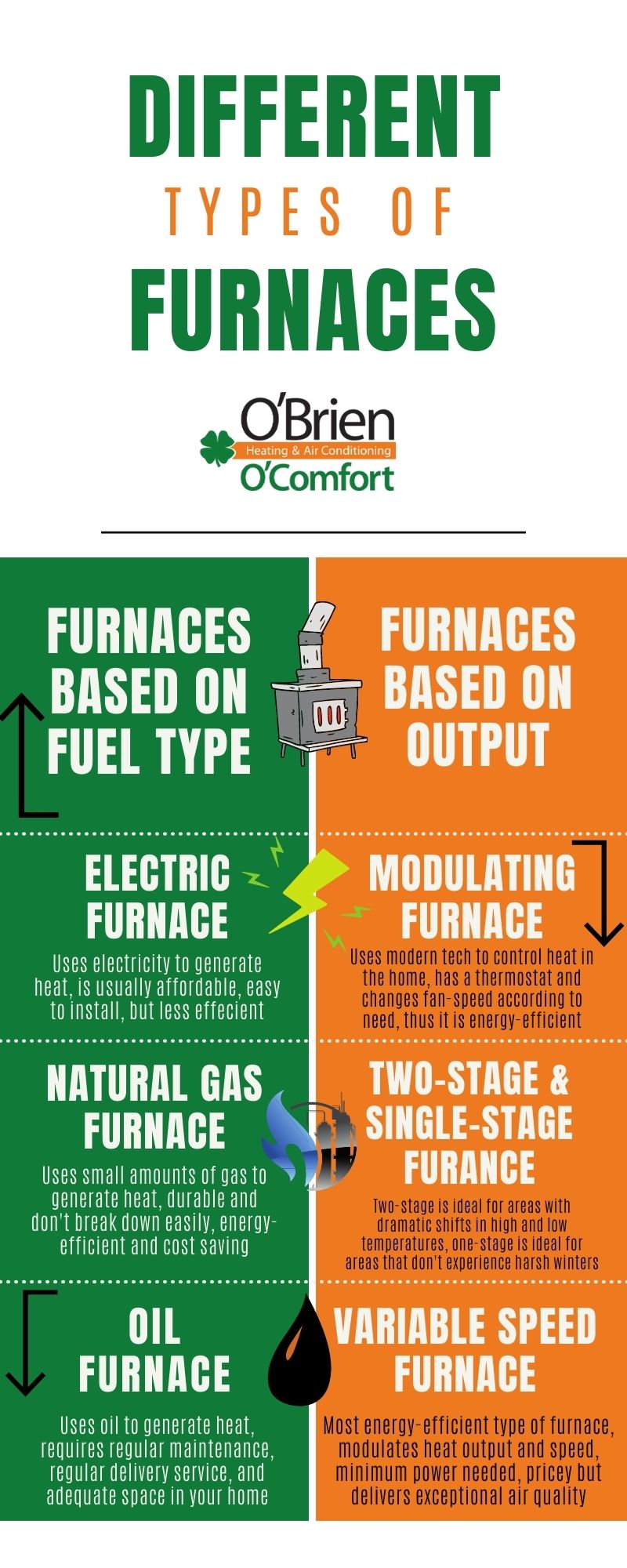 Furnaces are commonly used due to their quiet operation, energy efficiency, and durability. They are compatible with other units or can be used alone. Furnaces create warm air, and their ductwork may participate in cooling your home as well. They come in various sizes, but you can consult us at O'Brien Heating & Air Conditioning to get the right fit. Furnaces fall under two categories based on speed and fuel use. Here are the different types of furnaces.
Furnaces are commonly used due to their quiet operation, energy efficiency, and durability. They are compatible with other units or can be used alone. Furnaces create warm air, and their ductwork may participate in cooling your home as well. They come in various sizes, but you can consult us at O'Brien Heating & Air Conditioning to get the right fit. Furnaces fall under two categories based on speed and fuel use. Here are the different types of furnaces.
Furnaces Based on Fuel Type
There are a few different fuel types that your furnace can run on. Here are three options:
1. Electric Furnaces
An electric furnace is popular among homeowners. As the name implies, it uses electricity in its operation to generate heat. An electric furnace is usually affordable to purchase. You will cater to the bills at the end of the month due to energy consumption. An electric furnace is less efficient due to high power usage. On the bright side, it is easy to install and fits limited space, thanks to its small size.
2. Natural Gas Furnaces
This furnace uses natural gas that comes from a municipal line. Gas furnaces are durable and don’t break down easily. In addition to that, you can cut down on energy costs since it is a cheap way to warm your home. Natural gas is safe and clean; therefore, you don’t have to fret about pollution. Gas furnaces produce a lot of heat when burning, meaning that you can use a small amount to warm your house. They are utterly energy-efficient and cost-saving as well.
Under this category is the propane furnace that utilizes propane as fuel to warm your indoor space when it’s chilly outside. To power your furnace, you can get propane from large tanks outside your house. Propane is effective due to its ability to burn and heat your home quickly. It is a byproduct of gas and oil production, meaning it has more heat than other fuel categories.
3. Oil Furnaces
You can opt for a furnace that uses oil to generate heat for your residence. Many people in the North-Eastern U.S. prefer using oil furnaces. The furnace needs adequate space to store oil that keeps the equipment running. Plus, you should know a reliable delivery company to ensure you have enough oil at all times. An oil furnace requires routine maintenance to manage soot and dirt buildup. You can count on us at O'Brien Heating & Air Conditioning to clean the chimney and change oil filters.
Furnaces Based on Output
Furnaces can cycle on and off based on a number of principles. Here are four types of furnaces based on their output strategy:
1. Modulating Furnace
A modulating furnace features modern technology so that you can control the heat in your home. It has a thermostat for regulating gas to reach the temperature that you desire. Instead of cycling on and off like a traditional furnace, this type of furnace will increase or decrease the amount of fuel burned while constantly running. The furnace is energy-saving since you can run it at a low fan speed. You don’t have to shut it off completely when it isn’t in use. The best part is that you can achieve even temperatures for greater comfort. A modulating furnace is ideal if your experience lengthy winter periods. The furnace maintains heat within 1 or 2 degrees of the desired temperatures. It frequently runs to warm your indoor space.
2. Two-Stage Furnace
The furnace comes with two operating options as the name suggests. You can keep the gas at low/half power or full power according to your heating needs. A two-stage furnace collaborates with a thermostat to regulate the power to warm your home. You can use half power to heat your indoor space during cold days. When it gets colder, it automatically switches to full power.
3. Single-Stage Furnace
A single-stage furnace has one valve allowing gas to flow at a high rate. Usually, speed is constant, and the operation is quite noisy. Installation is affordable, but the furnace is less efficient than the two-stage type. On the bright side, the furnace lasts for a lifespan and requires minimal repair or maintenance. It is ideal for areas that don’t experience harsh winters. You can use it at an optimal level to warm your home when it’s relatively cold outside.
4. Variable Speed Furnace
A variable speed furnace is the most energy-efficient type that you can consider. It modulates heat output and speed to attain the desired temperature. You can run the furnace with minimum power and still feel warm during the frosty months. A variable speed furnace delivers exceptional air quality. The indoor fan usually circulates fresh air through the filter, including times when the furnace isn’t heating. The furnace is pricey, but it’s an excellent investment due to energy savings.
Call Us to Learn More
Furnaces differ depending on the operation technique and the fuel that they use. Some function quietly while others run with minimal noise. Choosing a furnace that suits you depends on your budget and heating needs. Contact O'Brien Heating & Air Conditioning for more information the different types of furnaces.

